PSG stars overpower Bayern to end Ancelloti’s tenure
The Carlo Ancelloti era at Bayern came to a sudden conclusion after an underwhelming performance on Wednesday evening. This match was Champions League group stage match that many across the world anticipated once the draw was made back in August, only for it to be notable for the wrong reasons for Bayern. For Paris St. Germain, the match came as an opportunity to show to the world if they are worth mentioning as a club with legitimate hopes of winning the competition with their reloaded squad. With both sides won their opening Champions League fixtures, PSG comfortably took the top spot in the group after a decisive victory over the German champions.
With Neymar, Kylian Mbappe, and Edinson Cavani leading the line for PSG, Bayern were in for a challenge against the home side, compounded by Manuel Neuer’s absence due to injury. Bayern opted to put Mats Hummels on the substitutes bench, along with options like Sebastian Rudy, Franck Ribery, and Arjen Robben. Jerome Boateng wasn’t even fielded in the match day roster, so it doesn’t appear as if Bayern were at full strength with this squad that was chosen. Perhaps Carlo Ancelotti felt that this was the squad that was best for defeating PSG. It’s difficult to know for sure, but there are many questions that could be asked about the selection.
The home side played a line up quite similar to their 2-0 win over Lyon from just over a week ago. The only changes from that team were in defense and midfield, where Marco Verratti replaced Julian Draxler, taking a deeper role in midfield and having Thiago Motta play a holding midfielder, thus changing the shape from a 4-2-3-1 to a 4-3-3. Across the back, Marquinhos slotted in for Presnel Kimpembe for this match. Given the importance of this match, Unai Emery made sure that his best team was rested and fit for this match, as shown in his decision to rest Neymar the prior weekend.
Out of Possession
The Parisian side initially started out looking to pressure in their attacking third aiming to stifle Bayern’s build up right from the kickoff and in the opening minutes of the match. During these moments, PSG’s press was conducted in a 4-2-4-0 as a base shape, standing off about 25 yards from to establish their structure and organize themselves. Once PSG moved to press, Verratti or Rabiot (more often the former) would move up to join Cavani to close down Martinez and Sule, with Thiago Motta replacing the player that would go move ahead, morphing into a 4-0-4-2.
In this, Cavani would use his cover shadow to prevent Bayern from having the opportunity to switch the play. When Verratti or Rabiot applied pressure, he would aim to use his cover shadow to prevent passes up the field into Thiago or Vidal, therefore forcing them to play wide or long in the construction of their attack. As Bayern had to options to play into the zones between the midfield and defensive lines in this pressure, Sven Ulreich (who does not possess the ability to play those balls successfully at a high percentage), was resigned to play up the pitch haphazardly or to the outside backs, the only players left free by Emery’s men.
However, after getting on the scoresheet early, PSG became more comfortable with Bayern maintaining possession of the ball and didn’t use their high pressing nearly as much. In the midfield areas, a 4-1-4-1 was favored which restricted the space centrally that Bayern could use for the development of their attack, but the compactness wasn’t extraordinary despite the stability of the team throughout the match. As will be discussed later with Bayern’s attack, most of their wounds when it came to their attack were self-inflicted, as with the inconsistent defensive participation Mbappe and Neymar, valuable spaces would open up as Rabiot or Verratti would shift to compensate for their role, but Ancelotti’s men were unprepared to capitalize on the downsides of Emery’s strategy designed to get the best out of two players worth the GDP of Tonga.
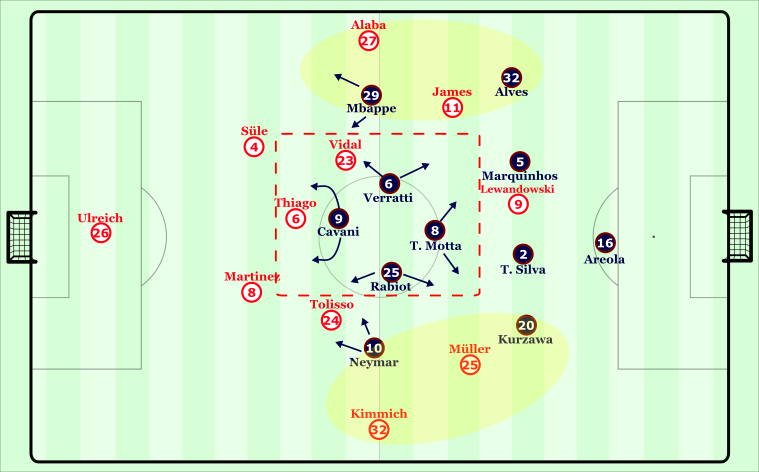
PSG’s General Defensive shape and movements throughout the night, with Bayern’s general areas of focus highlighted in yellow.
For the Bavarians, their plan was also to prevent the home side from playing into central areas, presumably to deny passing lanes into Cavani and Mbappe, who floated centrally to bolster the attack. Starting from the goal kick, Bayern’s front players would step up in man orientations so Areola would not play the center backs on either side of the penalty area. Vidal and Tolisso would occupy spaces between the respective full back on their side and the closest player, so as to when the ball was played, they could conceivably close down the receiver regardless of who the target was. Given the skill of Alves and Kurzawa, they were favored targets of Areola, and a common way throughout the whole match of solving Bayern’s pressure.
Moving into open play, the away sides 4-3-3 converted into a 4-3-2-1 during the opposition’s possession, with James and Muller taking more central positions closer to the midfield three. Tolisso would also slide to the right side in some instances while Muller would join Lewandowski up high. With James retreating, a 4-4-2 structure would result that was commonly seen in the later stages of the first half. However, no real design of the midfield pressure really took place, as it was common to see one player chasing without support from his teammates and a lack of synchronization between defensive actions in midfield. Thiago Motta, Verratti, and Rabiot were all skillful enough in their ball circulation to bypass any perceived problematic situations. However, the fact that three of them frequently had to congregate together in order to receive the ball is a credit to Bayern’s midfield structure, as progression down the center proved difficult for PSG and most progression from their end was either long passes over the top, or finding the wide options that were not sealed off in Bayern’s defense.
Bayern’s Attacking Approach
After conceding two minutes into the match, Bayern were left in a position where they were chasing the game as a result of being down a goal. With PSG happily deferring possession for periods, Bayern were in a position where they could probe the home side and get themselves back into the game using their talent to their advantage. Unfortunately though, Pep Guardiola is no longer manager, and the positional play seen during his tenure has essentially disappeared, as shown with the poor positioning of Bayern’s midfield and attackers during consolidation and their heavy reliance on crossing and corner kicks as methods of chance creation.
With Ancelloti’s 4-3-2-1, the most puzzling decision was the positioning of the central midfielders. He chose to field Thiago as the pivot with Corentin Tolisso and Arturo Vidal ahead of him, neglecting that the Spaniard is one of the best players in tight spaces in the world and thrives in more advanced areas of the pitch with his dribbling to create passing options and ability to form combinations with those in front of him. Both Vidal and Tolisso resemble different profiles in their play, with the former Lyon man more of a controller than Vidal, who surged forward in attacking whenever he deemed necessary. But with the most skillful player in tight spaces the furthest guy back, right away one could forecast some potential positional problems in how Bayern behaved in possession.
Both Tolisso and Vidal presented incorrect solutions for Bayern when confronted with PSG’s defensive structure. Rather than position themselves higher up the field with the view of potentially freeing up James and Muller and having the center backs be able to play to their feet, they instead dropped deeper in front of Cavani and created a wildly unnecessary superiority of 5v1 when building up their attack. As seen in the graphic below, this created large distances between the lines of the attacking players and the midfielders, leaving little connection between the groups of players. This makes clean progression up the field difficult to say the least, and vastly limits the amount of quality options available to play forward for the man with the ball.
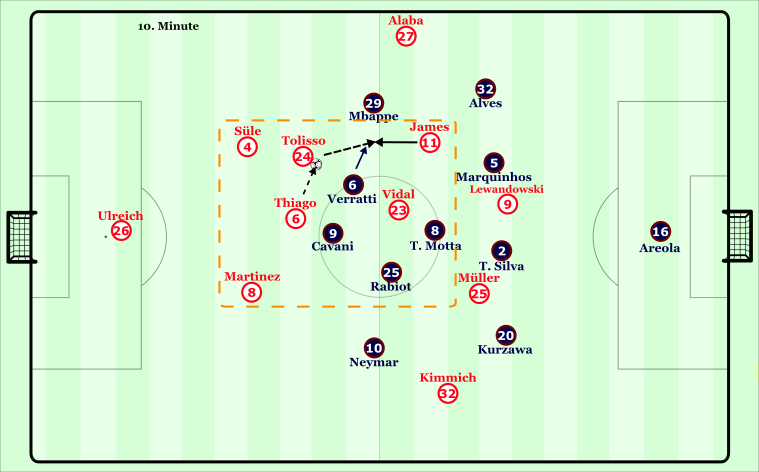
Here Tolisso drops excessively deep, creating a superiority in an area where it is not needed to move up the pitch.
Tolisso in particular was of note of this behavior, as he would often be seen standing next to the center backs as Bayern were circulating the ball. He usually would be oriented more towards the right side, likely acting as cover for Kimmich who would go into higher spaces to connect with Muller, but did not impact much during build up.
With Arturo Vidal as the other player in his line, it was not the best combination to break down a team aiming to keep it compact and force inventive play in order to defeat them. Vidal’s issues with Guardiola’s positional play are well chronicled, as he would often be at the wrong place at the wrong time and have a strong reluctance to play forwards. This in addition to not being as quick and clean on the ball as other members of the Bayern squad, Guardiola on occasion rotated him in wide areas with Phillip Lahm, so that Lahm could move inside during the attack and Vidal would return centrally in defense. This disdain with Vidal’s performance’s on occasion is summed up perfectly by this video from a match against Bayer Leverkusen in 2015, with Guardiola’s reaction the focal point of some of the downsides of fielding Arturo Vidal on the pitch.
With very little central options up the field to connect with the attack, the only option by default was to progress using wide areas and the quality that was available in those spots. On the surface, this doesn’t seem like an awful idea, as Neymar and Mbappe are not the most industrious defensive presences in the world and are of much more value higher up the pitch. Therefore, creating numerical superiorities in wide spaces would be easy and progressing in those spots wouldn’t be as difficult as going through the center would be.
This was how Bayern managed to have as much time in the attacking half of the pitch as they did (along with PSG not applying much pressure to the ball carrier). Through the axis of Muller-Kimmich on the right and David Alaba on the left (James was not influential), the German club moved up the field either through dribbling and taking advantage of space provided, or via vertical and linear passing which was easy to predict. It was still moderately effective due to the skill levels of the players being able to technically execute the passes, despite PSG knowing the trajectory of them.
As a result of not being able to generate any attacking momentum in the center, Bayern pounded PSG with crosses throughout the match. This was their primary form of chance creation and really the only method in which they were able to get shots on goal, along with the 18 subsequent corner kicks that followed PSG attempting to clear their lines and prevent headers on goal.
Despite being able to generate 16 shots on goal, all with exception to one or two posed almost no real danger to the hosts. While this could be attributed to PSG’s deep block as they faced the barrage of crosses, it also can be explained by the structural point from earlier. By having the midfielders so deep, they are unavailable to provide additional numbers in the box when service is provided in the box, leaving Lewandowski (and Muller sometimes) heavily outmatched, meaning the ball has to be exceptional in order to create a quality scoring chance. If there were options higher up the pitch, not only would the progression up the pitch be better, but also the chance creation and finishing of those chances would’ve been better, as there would be more options in the penalty area for these crosses. This pattern indicates how ineffective Bayern’s attack was and how easily the one-dimensionality of their wing play was dealt with by a team with high level defenders.

In this example, due to the great distances between midfield and attack, Kimmich is left with one option to cross to after Tolisso passes the ball and Kurzawa joins Neymar in pressuring. This play ensues in a corner for Bayern, one of 18 throughout the match.
Their attack could’ve been greatly improved if there were a greater far-side halfspace presence when they were building within PSG’s half. The player who could’ve provided this option at the highest frequency was Tolisso, presumably too caught up in his duties covering Kimmich and the non-existent threat of Neymar being 30 yards away from him during possesion. If he were to provide this option, PSG’s defense would’ve been more suspect to being unbalanced as a result of a diagonal pass from the left side at which they often attacked, since the shifting that takes place as a team is a larger total distance than if the passing is just vertical or horizontal. It would also make switching the play easier and add more options while removing predictability for the player on the ball, forcing PSG to defend more space rather than just set their focus to one particular area.
Since this was not done, the ball carrier was left with no options besides playing up the wing or crossing into the box, a clearance, and the whole process would reset itself with every attack. When it comes to all aspects of football tactics, form fits function, or that the organization and structures of your players on the pitch should be symbiotic and supportive of how you want your team to play. Therefore, a structure with players in all vertical zones of the is required to implement some form of effective positional attack, in the same way that having players with close distances with each other is required if you want to implement a defensive system where pressure from multiple players can be applied to the ball carrier easily. Structural integrity is not just something that is discussed to stir up conversation. It is the fundamental component of team tactics and aiming to get the best out of a particular group of players.
If Carlo Ancelloti wanted his players to be able to have some foothold in the center of park, he failed at transmitting this message, as his midfielders failed to be in positions where they could exert influence in the middle and control the spaces in which they play. This led to few options ahead of the ball besides playing up the wing or cross. When combined with the increasing urgency to get numbers into the box to score to even the scoreline or get themselves back into the match after going 2-0 down, the perfect blend for PSG was in the works for unleashing their prized attackers.
Les étoiles
Now onto the headline grabbers. This match was dominated by the front three of Paris, who have the potential to be the most exciting attacking line this year. PSG have designed their entire attacking strategy around the trio and have more or less deferred most attacking duties to them, with Rabiot and Verratti acting as support if they need it during circulation, while the full backs provide width just underneath if Neymar or Mbappe were positioned inside.
Mbappe frequently drifted inside just underneath Cavani to show an additional option in the center to play too, as Motta and Verratti each have high propensities to show deeper to receive the ball, not too dissimilar from Thiago and Tolisso did. The difference being with PSG is that their attack was designed to be more direct and their possession acted more as game management after they took they lead than it did as the primary way of getting to goal.
When it came to penetration, it largely came in two forms. It was either acheived through the dribbling prowess of Neymar and Mbappe, which Bayern struggled to deal with all evening, or Mbappe’s coveted ability to run in behind defenses thanks to his pace as seen with a tweet of mine below. With the second trait, the threat of that is an effective way of dismarking, and his ability to get free of Sule was influential in creating opportunities for himself and his teammates, particularly on the counter attack.
A reason Mbappe is so coveted is his timing of movements into depth. Combined with his pace, he's a huge threat on the counter & in the box. pic.twitter.com/1oZJ9gFPTa
— Austin Reynolds (@AReynolds70) August 15, 2017
With the dribbling abilities of Neymar and Mbappe, their ability to beat players on the dribble as a means of opening up passes for other players or creating shooting chances for themselves is among the world’s best. After all, they didn’t cost nine figures for nothing. Dribbling has several upsides to it as an action, namely how the danger of someone dribbling the ball gravitates other defenders toward the ball if one player is beat, due to a team’s natural inclination to close down the ball so that they can protect other valuable spaces. This helps explain why players who are particular skilled dribblers can have 2-3 players trying to slow them down, since they understand the intrinsic danger of having a player like that regularly beat defenders.
For PSG’s first goal, Neymar’s dribbling threat caused Bayern to greatly overcommit numbers to him, which was aided by the diagonal movements of Mbappe and Cavani toward the Brazilian, seemingly worried about the probability of him beating more players on the dribble and shooting. In the process, Bayern neglected access to the right side of the pitch, leaving Dani Alves open to run into toward the top of the penalty area and finish. Neymar’s magnetic dribbling posed problems for Bayern throughout the contest, as whenever he would move out to the left wing to receive the ball, Javi Martinez’s starting position would drift wide as a result, opening more space in the interiors for Mbappe and Cavani to run in behind. In fact, Neymar missed two chances in what could aptly be described as an off night for him. His frustration was evident throughout with himself for squandering quality chances, but found himself on the scoresheet in minute 63.

One example in the match of how Mbappe’s dribbling ability draws defenders toward him, freeing up the space inside for others to create opportunities on goal.
Mbappe had a similar experience throughout the match as well with Niklas Sule when he would move toward the right flank. Sule would follow him as a manner of coping with the danger he provided and also since Alaba was caught higher up the pitch in the attack. Partnered with Dani Alves on the right, the two of them frequently posed issues down Bayern’s left flank throughout the evening in terms of their urgency in transition and timing of their runs forward to get on the end of passes from one another. Due to the qualitative pace advantage that Mbappe possessed coupled with his dribbling ability, he was an influential creator for Paris St. Germain, as reflected in his two assists.
The biggest threat for the home side when it came optimizing their star men’s impact was on the counter. Once Bayern entered into the final third, typically one of Mbappe or Neymar would stay higher to join Cavani so there would be an outlet to play to once they win the ball so they could break. Rather than stay high up the pitch in line with Bayern’s defenders, they would drop deeper and pinch inside into their respective halfspace. Once the counter began, this gave whoever the runner was a headstart to reaching top speed in relation to the defender, who would be facing the other direction as well, or what is considered a dynamical advantage. This made any through balls played into the oncoming runners more effective, as their deeper positioning gives them more time to hit their highest speed and additional time for the player with the ball to consider which option to use and play the proper weight of the pass.
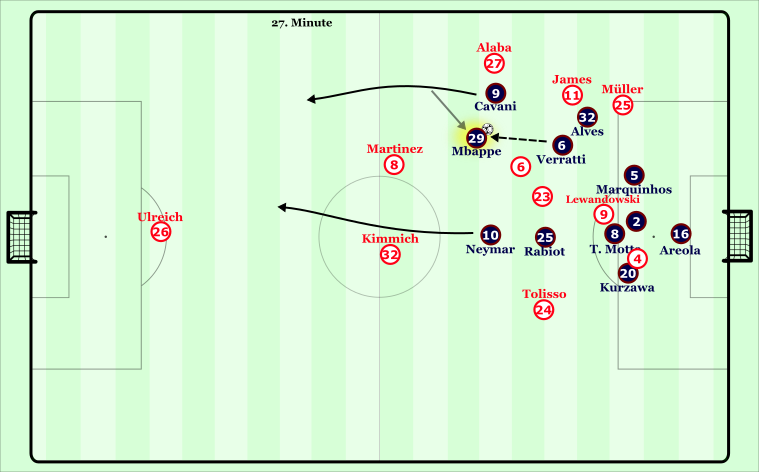
One example of one of PSG’s front three dropping into the halfspace to create room for himself, with the supporting runners having a dynamical advantage over Kimmich and Martinez.
Overall, PSG were quite reliant on their star talent up front, and even though the three of them put together impressive individual performances, the team performance from PSG wasn’t that formidable. While the three of them were switched on for the occasion, teams that are more stable in transition and defensively minded should be able to cope with most of the attacks that Emery’s club displayed. Bayern were so vulnerable partially because of overcommitting numbers on the ball into zones that cannot access the center easily to defend transitions, in addition to a lack of staggering in the penalty area to be able to prevent the supply into the forwards. PSG looked good, but they didn’t perform at a level where they can be considered favorites for the Champions League just yet.
Later Developments
To start the second half, Sebastian Rudy took place of Tolisso and Thiago was moved up to the 8, allowing him to have more of an influence higher up the pitch. Kingsley Coman replaced James Rodriguez and played narrower in relation to where the Colombian roamed in the first half. There was a slight improvement in Bayern’s attack when it came to the quality of their progressions and attacks, but largely the same trends existed as the first half. Once Neymar scored the final goal, the game began to spread out and PSG continued to threaten on the counter attack, but it was largely the same story as the first 60 minutes.
Neymar, presumably looking for glory, began to dribble at a much higher frequency than he did earlier in the match to try and put on a show, which only led to Bayern fouling him and targeting him with aggressive challenges. All of PSG’s substitutions were just to give players who performed well rest, but it is scary from a rival’s standpoint to think about Julian Draxler coming into the game in the 88th to kill time, speaking to the depth of quality Paris have managed to bring in.
Conclusion
This match was evidently the last straw for the Bayern board when it came to the team’s performance under Carlo Ancelloti. It isn’t the business of Spielverlagerung to speculate why the board chose to part ways with the Italian, but with Willy Sagnol taking charge on an interim basis for now, they will be one to watch and notice if there is any supposed improvement with the Frenchman at the helm.
It would be intruiging to see how the match would’ve played out with a healthy Manuel Neuer, as the first goal which tucked underneath Ulreich’s legs appears like it would’ve been saved by the titanic goalkeeper. Add in some additional replacements in team selection such as Rudy from the beginning, Ribery and Robben, and the match could have been entirely different. However, that is what the challenge and beauty of the Champions League is, as managers must find the right squad for the right opponent, and that often means in the later stages sitting exceptional players who easily could’ve made an impact on the match. When it pays off, the manager is the hero, and when it doesn’t, the footballing world turns against them. Football, bloody hell.
For an additional perspective of the match, TR analyzed this match on our German site if you would like to check that out.


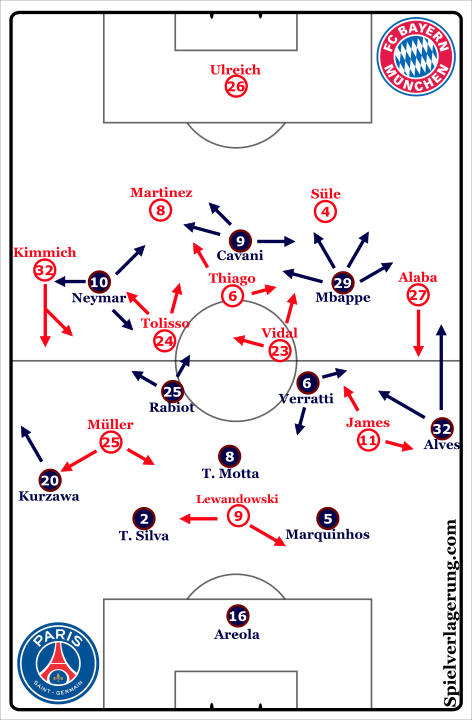
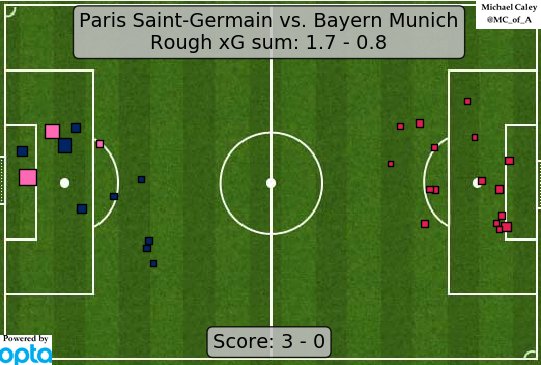
Keine Kommentare vorhanden Alle anzeigen